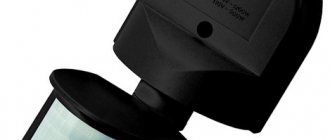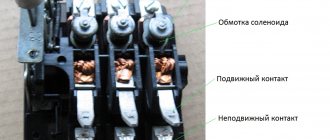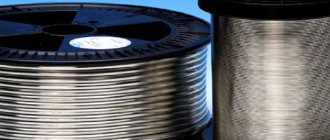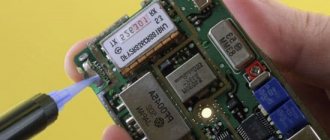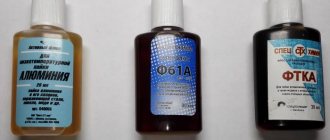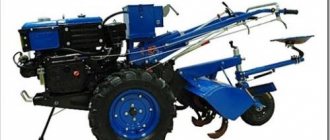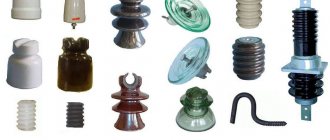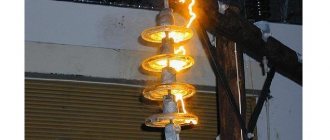What types of solders are there?
There are a large number of materials for soldering, the main division is into soft and hard. Radio equipment is installed using low-melting material; its melting point ranges from 300 to 450 °C. In terms of strength, soft types of solders are not inferior to others when soldering; they are used in the assembly of almost all electronic products.
The soldering process is based on an alloy of tin and lead with a certain standard and quantity.
Some refractory solders have steel alloys, which makes it possible to implement certain parameters when connecting. Impurities are used to achieve certain characteristics, anti-corrosion properties, and strength levels. Solder for soldering is used in most cases of the POS brand, which means tin-lead solders. The number indicates the percentage of tin in the composition.
Tin-lead solder
If a situation occurs where solders and fluxes used in soldering are of unknown origin, they can be distinguished by the following physiological properties:
- The melting point of lead-tin solders varies from 183 to 265 °C.
- A bright metallic sheen indicates a high tin content, presumably grade POS-61 and higher.
- A high lead content is indicated by a dull gray tint and matte surface.
- A large amount of lead increases the ductility of the wire; a product with a diameter of 6 mm can be easily bent by hand, but a higher quality product cannot be bent.
Different types of solder are produced by manufacturers depending on certain factors. Most modern soldering materials use a flux tolerance of 1 to 3%, which significantly improves working conditions. There is no need to bring the tip of the soldering tool to the flux each time if it is contained in the solder core. A type of lead-tin product is POSSu brand solder. The designation involves the addition of antimony, is used in various industries, and is suitable for use with tin parts.
Solder Sn63Pb37
The most common type of solder used for soldering and tinning copper and bronze parts through which current flows is tertiary solder. The melting point of this variety is 190 °C, resulting in a sealed seam. The foreign analogue is Sn63Pb37, where the content of tin to lead corresponds to the name.
Other types
There are rare solders used for special conditions. These include:
- Nickel-based compounds used in parts operating at high temperatures;
- gold, used for vacuum tubes;
- magnesium, used in ferrous and non-ferrous metallurgy.
We will give examples of some of them, since there are a lot of them and it will not be possible to consider all types within the scope of the article.
Solder paste
Soldering microcircuits, installing SMD components on printed circuit boards, and complex repairs of mobile phones can be carried out using soldering paste consisting of no-clean flux and Sn62Pb36Ag2 alloy. The composition contains 62% tin, 36% lead and 2% silver.
The paste meets the basic requirements imposed on it by surface mount technologies (SMD components) in the electronics industry.
For aluminum
Lucas-Milhaupt Filalu 1192 NC solder has good fluidity and high adhesion to aluminum. They can be used to solder refrigeration equipment, car radiators, and air conditioners. Soldering aluminum to aluminum will not cause any difficulties even for non-professionals. Available in the form of a rod with flux inside. Melting point 577 degrees.
Composition structure: Si-11.94%, Fe-0.18%, Cu-0.01%, Mn-0.03%, Mg < 0.01%, Zn-0.01%, Al-rest, FLUS - 32%
For copper
Almost any type of copper, both soft and hard, is suitable for soldering copper. For example, you can use solders made of tin, lead, zinc, and silver.
Low temperature solders
Low-melting solders have a transition temperature to the liquid state of up to 450 °C. They are used in radio engineering connections, when soldering wires, and other works. The main components of such soldering products are alloys of tin, lead, cadmium or bismuth. In the process of degreasing and tinning technical boards, Wood or Rose alloys are used. Such substances become liquid already at around 70 °C.
Low temperature solder
Metals have different melting points, it is important to familiarize yourself with the composition of the solder before purchasing.
- Tin is a low-melting metal that is dissolved by sulfuric or hydrochloric acid. The metal melts at 232 °C; exposure to standard room temperatures does not affect it, but at -50 °C the composite crystal lattice is destroyed.
- Lead is popular due to its fusibility and easy processing. Only the surface exposed to ambient air is oxidized.
- Cadmium is used for anti-corrosion purposes when soldering tin and lead products. The material itself is toxic, melting at 321 °C.
- Bismuth is added to the composition due to its solubility in sulfuric acid and nitrogen media.
The most convenient form of release for soldering radio components is wire with a diameter of 2-2.5 cm. The composition of modern products is rosin, which acts as a flux.
Soldering of various metals and alloys
Products that have been cleaned and prepared for soldering should not be stored for a long time to avoid oxidation.
They should be loaded into an oven or container as soon as possible in a protective environment. Particular attention should be paid to removing air when soldering high-alloy steels and alloys containing easily oxidized elements. Air removal can be achieved by evacuation or purging of protective gas - argon. When blowing, the temperature should increase gradually, starting from room temperature to 800-900 C (1073-1173 K). This process requires significant consumption of argon. Evacuation is more rational, since it significantly reduces the consumption of argon. When soldering, controlling the heating temperature of the product is of great importance; overheating can have a harmful effect. The total time the solder remains in the molten state consists of the time:
t = t1 + t2 + t3
where t1 is the heating time from the melting temperature of the solder to the soldering temperature; t2 is the holding time for soldering; t3 is the cooling time from the soldering temperature to the crystallization temperature of the solder.
In the case of interaction of solder with the base metal, t1 should possibly be reduced. After the punk process is completed, it is necessary to remove the flux, clean the oxidized surfaces, eliminate sagging and areas of solder spreading, especially in those places that are subject to subsequent processing. The requirement to remove flux is caused by its possible negative impact, for example, the appearance of corrosion (in aluminum alloys).
Fluxes (for soldering aluminum alloy) are removed by washing with hot and cold water, subject to subsequent treatment in a solution of chromic anhydride. Borax-based fluxes form a hard crust on the surface. They are removed mechanically or by immersing parts in hot water. Brazed seams on aluminum alloys are treated with a metal brush and washed a second time to remove any fluxes that may remain in the pores of the seams. Spreading solder is removed by mechanical, chemical or electromechanical methods.
Various methods are used to control the quality of solder joints. External inspection of the seams is essential. The seams are checked for strength, density, and electrical conductivity. Soldered seams can be controlled by physical methods: X-ray scanning, the use of radioactive isotopes, and sounding.
In addition to testing soldered samples without destroying them, tests are often used to bring them to destruction. The results obtained from tests to failure of several samples make it possible to establish the mechanical properties of a series of similar products.
Carbon and low-alloy steels include steels with a melting point of 1450-1520 C (1723-1793 K). When low-temperature soldering of steels, mainly tin-lead solders with active fluxes are used. It is recommended to tin the parts before soldering. This speeds up the soldering process and allows for high mechanical properties of the joints.
More often, high-temperature copper-zinc solders with the addition of silver are used for soldering steels (melting point 940-700 C (1213-973 K). However, due to the easy evaporation of zinc, these solders are not used for vacuum punk. It is advisable to use them when soldering in an environment with low temperatures oxidizing properties, for example, products of incomplete combustion of a nitrogen-hydrogen mixture with flux in the form of borax, boric anhydride, etc. For soldering carbon steels, pure copper is also used as solder, especially when soldering in furnaces in a hydrogen environment. Copper spreads well, fills small gaps, while the strength of the connections exceeds the strength of copper itself.
Highly alloyed alloys include corrosion-resistant austenitic steels 0Х18Н9, 12Х18Н9 with stabilizing additives - titanium, vanadium, niobium, etc., acid-resistant chromium steels Х17, Х25 and others of the ferritic class, heat-resistant nickel alloys, for example, having about 80% Ni and etc.
These alloys can be soldered with low-melting solders using active fluxes. However, soldering of this group of alloys with low-melting solders is technically impractical. It is more rational to use high-temperature solders for their connections (Table 1).
Depending on the brand of solder, fluxes with different components are used. Some solders with rapid heating of the heating element. hours lose their components.
High-alloy alloys and steels can be soldered in argon, hydrogen, or in vacuum furnaces. The disadvantage of soldering in argon is the not entirely satisfactory spread of solder. To improve spreadability, additives, such as lithium, are added to fluxes. Soldering in a hydrogen atmosphere requires high purity; The use of hydrogen always involves some risk of explosion.
Soldering in a vacuum gives good results when using solders that do not contain easily evaporating elements (zinc, etc.). When soldering the above materials, pores may appear due to the evaporation of some components of the solder, for example, zinc: lack of penetration as a result of unsatisfactory wetting of the joined parts with molten solder or insufficient cleaning of surfaces; cracks when liquid solder penetrates between the grain boundaries of the base metal. Cracks form especially often when soldering with copper-zinc and copper-silver solders. By using higher temperature solders, cracking of solder joints can be avoided.
Table 1. Composition of solders, %
The use of nickel solders is sometimes accompanied by the formation of undercuts in the base metal at the transition points to the seams. This is due to the fact that this type of solder has the ability to dissolve the base metal. To avoid this phenomenon, the soldering process should be carried out at the lowest possible temperature. By means of soldering, products made of pure copper and copper alloys are well connected. Pure copper solders well when heated in vacuum furnaces, as well as in an atmosphere of well-purified hydrogen without any oxygen impurities. Copper-zinc alloys containing 4-38% Zn lose it when heated for a long time (zinc evaporates), so it is advisable to coat brass parts with copper before soldering.
Soldering is widely used for joining various bronzes; aluminum containing 5-10% Al; beryllium, used in instrument making and containing 2-2.5% Be; chromium, containing about 0.5% Cr; tin, used in pressure treatment, containing tin, as well as phosphorus, etc.
Copper and its alloys are easily soldered using low-temperature solders using rosin fluxes that do not cause corrosion. Often, before soldering, the surfaces of parts are tinned with a layer of pure tin with a thickness of 0.005 mm on steel and 0.0075 mm on copper. Low-temperature solders do not provide high strength solder joints, so soldering in ovens with high-temperature hard solders is recommended. It is advisable to use copper-phosphorus and silver solders and fluxes based on borax with the addition of fluoride compounds. Aluminum bronzes are well soldered with silver solders with nickel, which prevents the penetration of aluminum into the solder and increases the productivity of the technological process.
Titanium and its alloys are soldered in electric furnaces, i.e. h., gas-flame burners. The best mechanical properties of the junction are achieved when soldering HDTV. This is explained by the fact that as a result of the shortening of the thermal cycle with this soldering method, there is no grain growth, leading to brittleness of the joints. When soldering titanium alloys, it is advisable to use silver solders having a melting point below the recrystallization temperature of titanium and above the temperature required to satisfy the conditions for wetting the soldered parts with solder.
A very important production task is the connection of various types of ceramic materials and oxides with each other and with metals by soldering. Different cases are possible: metals are more refractory than ceramics, while the connection of both parts occurs in a solid state, contact is ensured by the necessary pressure and the use of coatings. In the latter case, the connection is achieved at temperatures below the melting point of each of the parts being connected.
Particularly favorable conditions for bonding are when metals have a melting point lower than the melting point of ceramics and, as a result of their specific chemical properties, are prone to form a bond with the latter. For example, titanium and zirconium have a high affinity for oxygen and form solid solutions with many metals and oxides. Oxides of titanium and zirconium are very refractory. Under certain conditions, these metals reduce the oxides of the metals that form the ceramics and absorb the released oxygen. This reduction required for press brazing should be carried out under vacuum or argon conditions.
A serious difficulty in soldering ceramics with metals is the significant difference in their temperature expansion coefficients, as a result of which residual stresses of significant magnitude are formed in the joints. In unfavorable cases, when the materials have insufficient plasticity, cracks appear in them. To eliminate this phenomenon, sometimes plates of ductile metal, such as molybdenum, are placed between the metal being joined and the ceramic. With plastic deformations of the latter, the risk of cracks in ceramics is significantly reduced.
With the help of special filler metals, it is possible to obtain high-quality compounds not only of homogeneous elements, for example Al2O3 + Al2O3, but also of dissimilar ones. Alloys containing strong carbide-forming elements - molybdenum, tantalum, titanium, zirconium, etc. - wet graphite well.
Brands of soft solders for soldering with a soldering iron
Soft solders are used in conjunction with an electric soldering iron and flux. The tin included in the composition is an environmentally friendly product and can be used to connect elements of the food industry. The most common soldering product is the tertiary, which got its name due to the composition containing a third of lead . Soft solders are divided into varieties according to their purpose and melting temperature.
Solder POSV-33
Low-melting solders are used for soldering heat-sensitive parts such as fuses and transistors. The composition includes lead, tin, bismuth and cadmium, the latter material is toxic and is not used in all areas of activity. Melting of Wood's products begins at the lowest temperature - 69 °C.
Domestic brands of products are labeled POS; with the addition of some substances, the name changes. For example, POSV - 33 has equal parts of lead, tin and copper, and is applied to brass and copper parts that require a sealed seam.
Main technical characteristics of soft solders for soldering with an electric soldering iron
The technical characteristics of materials used for soldering are divided into several parameters:
- conductivity or electrical resistivity is 0.1 ohm per meter. Tin-lead type solder conducts electric current an order of magnitude worse than aluminum or copper;
- Tensile strength is measured kg/mm; low-temperature solders do not include this parameter, because not designed for load. The parameter depends on the amount of tin; the more there is, the higher the number. For example, POS-61 brand solder has a strength of 4.3 kg per mm, and POS-90 solder has a strength of 4.9 kg/mm.
- The melting point depends on the purpose and components.
Brazing alloys
This class includes alloys whose melting point starts at 300 °C and sometimes crosses the 1000 °C mark. Due to this, their strength also increases significantly. The MPa value here ranges from 100 to 500.
In most cases, the base alloy is copper or silver. There are many variations in their combination with other metals. As a result, the melting point, mechanical strength, as well as physical and chemical properties change.
Among copper solders, PMC solders with the addition of zinc are the most widely used. The percentage of copper is indicated in the alloy marking. The most actively used solders are PMC-36, PMC-46, PMC-51 with a melting point of 825–870 °C.
Solders that are considered silver are actually alloys. A significant part of the composition is occupied by silver itself, and the rest consists of copper and zinc. Moreover, the abbreviation indicates only the amount of Ag. There are many varieties of such alloys, from PSr-10 to PSr-70.
Silver solders opened up new possibilities. Today, they are used to solder many metals together. They allow you to work with titanium, brass, bronze, nickel and other materials that cannot be soldered with more common solders.
Flux for soldering with a soldering iron
An auxiliary substance that promotes the spreading of soldering materials over the surface of the parts being soldered is flux. High-quality connections are created by solders and fluxes ; without one of the components, soldering is impossible. A common type of flux is rosin, made from hard coniferous trees. Softening occurs at 50 °C, and when the temperature reaches 250 °C, the process begins to boil the composition.
Flux for soldering aluminum
Due to the hydrolysis provided for in the manufacture of rosin, the material is not resistant to atmospheric influences. After soldering, it is necessary to remove flux residues, because... the compound may undergo an oxidation process. By absorbing moisture from the atmosphere, rosin can disrupt the operation of radio components.
Popular fluxes for soldering with an electric soldering iron
Soldering of metal joints occurs using various substances. Fluxes are divided into three main categories, differing in their area of application and method of preparation. The process of preparing elements for work may vary; after soldering, it is necessary to remove residues in the manner described in the instructions.
- Inactive rosin fluxes are used for soldering copper and other types of soft metals. There is a light rosin that is ready for use and does not include additional substances. Alcohol-rosin solution is made from components with a concentration of 1 to 5. It is used for soldering in hard-to-reach places, it is produced in powder form, and must be mixed with alcohol before use. Glycerin - rosin materials are used when a hermetic connection is necessary.
- Active fluxes suitable for soldering precious and non-ferrous metals include zinc chloride, alcohol or petroleum jelly. The last parameter differs in its composition, when used in a liquid or paste state. It is more convenient to work with flux as a paste; it is possible to apply it directly to the product in the required amount.
- Acid-active flux is divided into zinc chloride and phosphoric acid. It is performed in the form of liquid solutions or paste, using rosin, zinc chloride, alcohol or petroleum jelly.
Orthophosphoric acid
Orthophosphoric acid consists of water, ethyl alcohol and the acid itself with a density of 1.7. It is used for soldering stainless materials, copper, and silver. Alcohol-based fluxes must be stored in airtight containers. A convenient container for storage is a nail polish jar, the brush does not react to the active medium, and the lid allows you to tightly close the container, avoiding evaporation of the components.
Tinol soldering pastes for soldering
Among the substances offered, there are solder pastes that are produced with a mixed type of flux. It is used when installing open-frame elements in hard-to-reach places. Application occurs with a special spatula, then heating with an electric tool. The result is a reliable, high-quality connection, which is actively used by novice craftsmen in the absence of appropriate experience.
Tinol pasta
It is possible to prepare an alloy for soldering with your own hands; for this you will need the solder required by the element. Using a medium-grain file, tin for soldering in the form of wire is crushed to the state of metal chips. A flux selected from the above in a liquid state is added to the composition, after which the elements are mixed. The composition must be prepared in a small container, the shelf life is limited to 6 months, after which the metal oxidizes in an acidic environment.
What is flux?
Flux is an auxiliary material that is designed to remove the oxide film from parts being soldered during soldering and ensure good wetting of the surface of the part with liquid solder. Without flux, solder may not adhere to the metal surface. Purpose of fluxes: reliably protect the surface of the metal and solder from oxidation, improve the conditions for wetting the metal surface with molten solder. The effect of a flux depends on its composition; available fluxes either dissolve oxide films on the surface of the metal (and sometimes the metal itself), or protect the metal from oxidation when heated. Thus, the flux forms a protective film over the soldering area.
Soldering fluxes
Flux is already contained in modern solder in the form of a thin core. When solder melts, it is distributed over the surface of the liquid metal. The surfaces of already tinned metals are also coated with flux before joining them (actually soldering). In this case, flux is a surfactant, that is, a Surface Active Substance. After the parts come into contact, excess flux between them comes out and evaporates all the time because its evaporation temperature is lower than that of solder.
Fluxes are different. For example, to repair metal utensils, they use “soldering acid” - a solution of zinc in hydrochloric acid. You cannot solder radio structures with this flux - over time it destroys the soldering. For radio installation, it is necessary to use fluxes that do not contain acid, for example, rosin.
Use of tin-lead group alloys
The soldering process is the joining of several metallized parts together. In this case, the exposure temperature does not exceed the critical threshold at which destruction of parts or circuit boards occurs. The main objectives of using soldering products are to ensure the most even temperature viscosity, at which uniform spreading occurs over the surface.
Tin is used for soldering quite often; the material serves as a component of the largest number of solders. In its pure form, the metal is very expensive and is used for soldering important products and elements. Divided into categories with and without lead.
Lead solders
Various soldering materials are used using lead. The material is fusible, soft and easy to process. Easily dissolves in an alkaline environment and acidic impurities.
Lead solder
Products labeled PIC are considered the most popular in use. The percentage of elements allows you to work with different environments and materials. They differ in temperature and other parameters that are important for a reliable connection. Zinc, bismuth or antimony are added to lead compounds to provide protection against oxidation and other destructive factors.
Solder pastes
Solder paste (Tinol) is a mixture of solder and flux. This material cannot be replaced when soldering in hard-to-reach places and when installing unframed radio components. To do this, you need to apply the paste in the required amount to the soldering area and heat it with an electric soldering iron (full melting temperature 200°C). Flux residues after soldering are non-hygroscopic, non-conductive and non-corrosive.
You can make your own pasta. To do this, you need to choose a brand of solder and prepare sawdust using a file with a large notch. Then mix them with liquid flux to obtain a paste-like composition. The paste should be stored in an airtight container. The paste has a shelf life of no more than six months.
It is known that the main function of solder is good diffusion with the metal surface. In addition, it must have optimal temperature viscosity, allowing it to be evenly distributed over the surface of metals. This factor of high-quality tinning is possible only in the absence of fatty deposits and oxides on the surfaces being soldered, the removal of which is carried out by fluxes. Therefore, the final quality of the work will depend on what solders and fluxes you choose for soldering with a soldering iron.
How to choose solder
The main task for the master is to create a high-quality, reliable fastening that will last for a long time. Solder selection is based on the following parameters:
- Materials that are processed. It is necessary to accurately familiarize yourself with the characteristics of the materials being soldered. There is a temperature threshold for melting fragile elements, transistors, capacitors, etc. Radio amateurs use fusible substances.
- The composition of the solder is selected according to the parameters of thickness and purpose of the product. When soldering wires and other large elements, it is possible to use refractory elements.
- Some cases require choosing the optimal conductivity. The resistance of tin is lower than that of lead; more expensive brands of solder are used on high-frequency boards.
In any situation, it is necessary to be scrupulous about the compliance of soldering parameters and the product. High-quality products are used for soldering, the price is not high, and the choice on the market is huge.
Ceramic fluxes.
They are made in the same way as electrode coating.
The dry components of the charge are mixed in liquid glass. The resulting mass is crushed by pressing. Then they are calcined and sifted to obtain particles of a certain size. The dry mixture particles can be held together by sintering. This happens at elevated temperatures without melting. Then granulate to the required size.
Non-melting fluxes are prepared in the form of a mechanical mixture. The most common are ceramic fluxes. The composition is close to the composition of the main coating. Alloying metal with flux is achieved by introducing ferroalloys into their composition. The combination of alloying elements can be different, and this makes it possible to obtain almost any composition of the weld metal.
This is the most characteristic feature of ceramic fluxes.
The chemical composition of the weld also depends on the welding parameters.
To determine how the properties of the seam have changed, it is necessary to measure the hardness in various places.
The most critical zone is the fusion zone and the heat-affected zone. Ceramic fluxes also have their disadvantages: low strength, as a result of which their granulation changes during transportation or operation.
Often used for welding high-alloy and special steels, as well as for surfacing work.
Melting fluxes.
Alloys of metal oxides and salts. The process of their manufacture includes the following stages:
1. Calculation and preparation of the charge. 2. Melting of flux. 3. Granulation. 4. Drying if wet granulation was used. 5. Sifting.
Pre-crushed parts of the flux are loaded into arc or melting furnaces. After melting and holding until the end of the reaction at a temperature of 1400 C, the flux is released from the furnace.
In dry granulation, flux is poured into metal molds. After cooling, the casting is crushed using rollers. Particle size 0.1-3 mm. The fluxes are then sieved.
Dry granulation is used for hygroscopic fluxes containing large amounts of fluoride and chromium salts.
The advantage of these fluxes is that they can be used several times.
Used for welding aluminum and titanium alloys.
Wet granulation method: molten flux is released from the furnace in a fairly thin stream and falls into a container with running water. In some cases, an additional stream of water is used. Next comes sifting.
Various granulations are obtained. The flux is dried at a temperature of 250-300 C, and then crushed, if necessary. After this they sift.
The flux consists of uneven grains of light gray, red-brown and brown color.
Transported in sealed containers, plastic bags, barrels.
Melting flux cannot contain alloying elements in pure form, since they are oxidized during the manufacturing process. Therefore, alloying occurs by reducing flux oxides.
The classification of fluxes by chemical composition is based on the content of oxides and salts in it.
There are oxidizing fluxes containing manganese and silicon oxide in their composition.
To obtain certain properties of the flux, other components are introduced into its composition - fluorspar, more durable oxides.
The more manganese and silicon oxide in the flux, the more it can alloy the metal with these elements, but the more it will oxidize this metal.
Melting fluxes are used for welding carbon and low-alloy steels.
Non-oxidizing fluxes practically do not contain manganese and silicon oxides; they contain fluorides and are used for welding high-alloy steels. Also, non-oxidizing fluxes can consist of fluoride and chloride salts and elements that do not contain oxygen. Used for welding highly active metals - aluminum and titanium.
Due to the widespread use of fluxes, there is a GOST for the main grades: GOST 9087-81 “Welding melting fluxes”. Regulates the chemical composition.
A distinction is made between glassy and pumiceous grains. The grain structure depends on the composition of the flux melt and the degree of its overheating. Depending on this, the flux can be dense, transparent, porous, or loose. It should be taken into account that pumice flux, with the same chemical composition, has one and a half to two times less weight than glassy one.
These fluxes protect the metal less well from exposure to air, but provide good weld formation at high current densities and welding speeds.
Letters in flux designations:
- M – small
- C – glassy
- P – pumice-shaped
- SP – mixed

